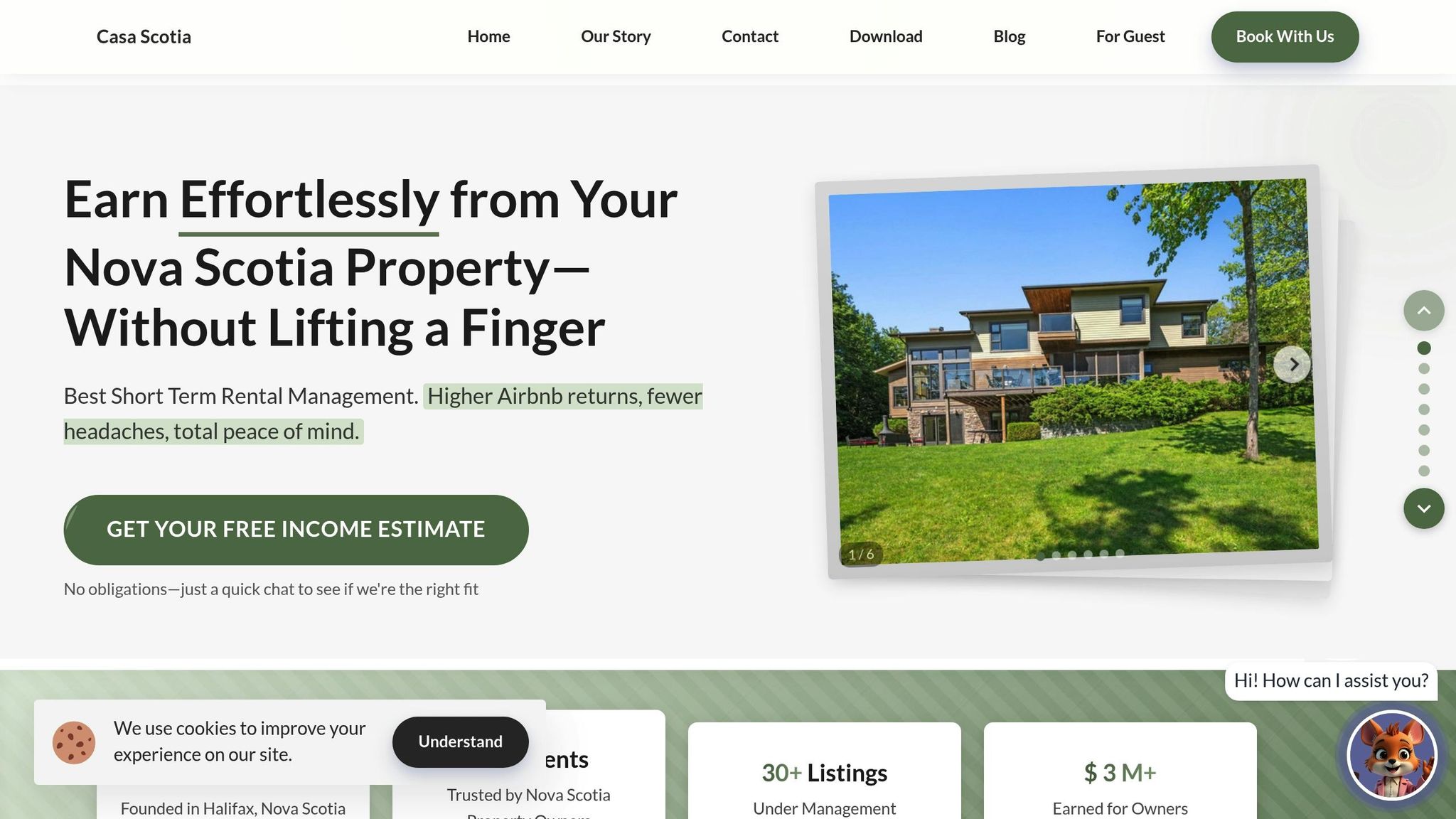Calculating your break-even point is essential for short-term rental owners in Nova Scotia. It tells you how many nights you need to book to cover your monthly fixed and variable costs, like mortgage payments, insurance, utilities, and cleaning fees. Without this, you risk underpricing your property or overestimating profitability. Here's how it works:
- Fixed Costs: Monthly expenses like mortgage, insurance, taxes, and mandatory registration fees.
- Variable Costs: Expenses that change with bookings, such as cleaning, utilities, and maintenance.
- Formula: Total Fixed Costs ÷ (Average Nightly Rate - Average Variable Cost Per Night).
For example, a Halifax rental with $2,517 in fixed costs and $115 in variable costs per night, charging $180 nightly, needs 39 nights per month to break even. Adjusting rates or reducing costs can help balance this, especially during seasonal demand shifts. Tracking expenses and using tools like dynamic pricing can improve financial planning and profitability.
Find Your Break Even Number | Short Term Rental Management
Fixed and Variable Costs Breakdown
Getting a handle on your expenses is essential for calculating your break-even point accurately. If you’re a short-term rental owner in Nova Scotia, your costs will fall into two main categories: fixed costs, which stay the same every month, and variable costs, which change depending on how often your property is booked.
Fixed Costs You Need to Track
Fixed costs are those recurring monthly expenses you’ll need to cover regardless of how many bookings you get. These are the baseline costs you must account for before you can start turning a profit.
Mortgage payments are usually the biggest expense. For example, Halifax landlord Andrew Warnica shared in November 2023 that his monthly mortgage payments for a triplex had risen to $2,100 [2]. Your mortgage will depend on factors like the purchase price, down payment, and interest rate.
Property taxes and insurance are another major expense. Warnica’s combined bill for these came to $600 per month [2]. Keep in mind, rental property insurance costs have jumped by 23–26% recently [2], which could impact your budget significantly.
Provincial registration fees became mandatory as of September 30, 2024 [1]. These annual fees vary based on your property type and location:
| Host Category | Property Details | Annual Fee |
|---|---|---|
| Primary Residence STR | Up to four bedrooms | $50 |
| Primary Residence STR | Five or more rooms | $150 |
| Commercial STR (Tier 1) | Halifax, Dartmouth, Bedford, Cole Harbour, Lakeside, Lower Sackville, Beechville | $2,000 |
| Commercial STR (Tier 2) | All other communities | $500 |
| Commercial STR (Tier 3) | Clark's Harbour, Digby, Lockeport, Mulgrave, Shelburne | $240 |
Municipal licensing and compliance costs are another part of your fixed expenses. Many municipalities require permits, inspections, and sometimes upgrades like installing safety equipment. These costs can vary but are important to factor into your budget.
While fixed costs are predictable, variable costs depend on how often your property is booked.
Variable Costs That Change Monthly
Variable costs are tied directly to your bookings and can fluctuate throughout the year. These expenses increase during busy seasons and drop when demand slows down.
Cleaning services are often the largest variable expense. Each guest turnover comes with a cleaning fee. During peak seasons, you might have multiple turnovers in a single week. For instance, a property booked for 20 nights in a month will rack up much higher cleaning costs than one booked for just five nights.
Utilities are another fluctuating expense. While basic usage costs remain steady, guest usage - especially during high-demand periods or harsh winters - can cause your bills to spike.
Property management and maintenance costs also rise with increased bookings. More guests mean more wear and tear, frequent maintenance, and higher spending on items like toiletries and linens. Short-term rentals generally see higher costs for cleaning, maintenance, and marketing compared to long-term rentals [3].
Nova Scotia’s peak tourist seasons, such as summer and the holidays, can drive up both revenue and variable costs. During these times, demand for vacation rentals surges, allowing hosts to charge higher rates [1].
Seasonal demand has a big impact on variable costs. For example, summer months might require more frequent cleaning and maintenance due to daily turnovers, while winter might bring lower variable expenses but still leave you responsible for covering fixed costs.
Tools for Expense Tracking
Keeping track of your expenses is crucial for accurate break-even analysis. Many rental owners underestimate their costs by overlooking smaller, recurring expenses.
Spreadsheet templates are a simple way to organize your fixed and variable costs. Set up separate columns for each category and update them monthly, being sure to account for seasonal changes.
Expense tracking apps can save time by automating the process. These apps often link to your bank accounts and credit cards, automatically categorizing expenses and generating reports. Look for apps that can separate fixed and variable costs and are tailored for short-term rental needs.
Receipt management systems are helpful for keeping digital records of all receipts, especially for variable costs like cleaning supplies, maintenance, and utilities. Many apps even let you capture receipts with your phone for easy storage.
The secret to effective tracking is consistency. Record every expense, no matter how small - whether it’s a $20 run for cleaning supplies or a $50 maintenance call. Over time, these small costs can add up and have a big impact on your break-even calculations.
How to Calculate Your Break‑Even Point
Once you've nailed down your fixed and variable costs, the next step is to figure out your break-even point. This calculation helps you identify how many nights you need to book to cover your expenses and make smarter decisions about pricing and marketing. Let’s break down the formula and see how it works.
The Break-Even Formula
The formula for calculating the break-even point in short-term rentals is simple:
Total Fixed Costs ÷ (Average Nightly Rate - Average Variable Cost Per Night).
This gives you the number of nights you need to book each month to cover your costs.
"A break-even analysis determines the sales volume needed to cover fixed and variable costs, indicating the point at which a business neither makes a profit nor incurs a loss." – Investopedia [4]
Here’s how it works: Your contribution margin per night is the difference between your nightly rate and your variable costs. For example, if you charge $150 per night and your variable costs (like cleaning) are $40, your contribution margin is $110. This $110 then goes toward covering your fixed costs, such as mortgage payments, insurance, and property taxes.
If you raise your nightly rate, you’ll need fewer bookings to break even. On the other hand, higher variable costs - like cleaning fees increasing from $40 to $60 - mean you’ll need more bookings to hit that break-even point.
Example: Nova Scotia Property Calculation
Let’s look at a practical example for a short-term rental in Halifax. Suppose you own a two-bedroom condo with the following monthly expenses:
Fixed Costs:
- Mortgage payment: $1,800
- Property taxes and insurance: $500
- Commercial STR registration fee: $167 (monthly, based on a $2,000 annual fee)
- Municipal licensing costs: $50
Your total fixed costs come to $2,517 per month.
Variable Costs:
- Cleaning fee: $75 per turnover
- Utilities per booking: $25
- Supplies and maintenance: $15
Each booking costs you $115 in variable expenses.
Average Nightly Rate:
Let’s assume you charge $180 per night, based on Halifax’s market rates.
Using the formula:
$2,517 ÷ ($180 - $115) = $2,517 ÷ $65 ≈ 38.7 nights.
This means you’d need about 39 nights per month to break even. With only 30 days in a month, this translates to a 130% occupancy rate - clearly not feasible. This suggests you either need to increase your nightly rate, lower your costs, or reduce turnover by encouraging longer stays.
Now, let’s see what happens if you increase your nightly rate to $220:
$2,517 ÷ ($220 - $115) = $2,517 ÷ $105 ≈ 24 nights.
An occupancy rate of about 80% is much more realistic and gives you some breathing room for seasonal fluctuations.
Adjusting for Peak and Off-Peak Seasons
Seasonal demand in Nova Scotia can significantly affect your break-even calculations. During peak season (June to September), you can charge higher rates, while off-peak season (November to March) often brings lower rates and reduced demand.
Peak Season
During peak months, rates in Halifax can climb 30–50% higher than usual. If your regular rate is $220, you might charge $300 to $330 per night. For a $300 rate:
$2,517 ÷ ($300 - $115) = $2,517 ÷ $185 ≈ 14 nights.
This lower break-even point allows you to build a financial cushion. For example, if you book 20 nights in July at $300 per night, your profit above the break-even point would be about $1,184.
Off-Peak Season
In contrast, off-peak months may see rates drop to $160–$180 per night. At $160:
$2,517 ÷ ($160 - $115) = $2,517 ÷ $45 ≈ 56 nights.
With only 28–31 days in a month, hitting 56 nights is impossible, meaning you might face a loss during these months.
To balance things out, many hosts use profits from peak season to cover off-peak losses. Monitoring your break-even point monthly can help you adapt your strategy. For instance, offering weekly or monthly discounts can encourage longer stays, reducing turnover costs and boosting your margins.
sbb-itb-b5e1074
Compliance and Tax Requirements
Navigating Nova Scotia's compliance landscape is an essential step in calculating your break-even point. To get it right, you’ll need to account for registration, licensing fees, and even potential fines as part of your monthly fixed costs.
Nova Scotia Short-Term Rental Rules
Starting 30 September 2024, the Short-Term Rentals Registration Act (STRRA) mandates that all short-term rental operators in Nova Scotia register with the province. The associated registration and licensing fees can vary depending on your property type, location, and local municipal regulations. These fees should be considered fixed costs in your break-even analysis. Ignoring compliance isn’t an option - non-compliance can lead to fines, which would only increase your expenses. Depending on your municipality, additional permits and fees might also come into play, so it’s worth double-checking local requirements. Beyond compliance, tax obligations also play a key role in shaping your cost structure.
Tax Rules and Deductible Expenses
The Canada Revenue Agency (CRA) treats short-term rental income as business income. While this means you’ll need to report earnings, it also opens up opportunities to deduct certain expenses. Registration fees, licensing costs, repairs, and property improvements are all eligible deductions. To make the most of these tax benefits, consider consulting a tax professional who can help you identify all applicable deductions and ensure you’re maximizing your savings. These tax rules should be factored into your overall financial planning and break-even calculations.
Tracking Compliance Costs
Keeping track of compliance-related expenses is just as important as paying them. Regularly record costs like registration, inspections, and certifications, and average them into your monthly expenses. Using cloud-based accounting tools can simplify this process and help you stay organized. These tools not only help you monitor your compliance costs but also ensure they’re integrated into your break-even analysis. After all, compliance and tax-related expenses directly influence your fixed monthly costs, so keeping a clear record is key to maintaining financial clarity.
Casa Scotia Services for Better Results

Get your property to break-even faster with Casa Scotia's tailored management services. Designed for Nova Scotia property owners, these services aim to boost revenue while cutting down the time spent on daily operations. Here's how they simplify your financial management and improve outcomes.
Dynamic Pricing for Higher Revenue
Nailing the right nightly rate can make all the difference between just covering your mortgage and surpassing your break-even point. Casa Scotia's dynamic pricing tools take the guesswork out of rate-setting. Using real-time data, these tools adjust your prices based on Nova Scotia's market conditions, seasonal trends, and local demand.
From the bustling summer tourism along the coast to the winter ski season, the system adapts to Nova Scotia's unique travel patterns. This ensures your rates are always optimized to match demand, helping you meet - and even exceed - your financial goals.
Real-Time Tracking and Reporting
Accurate pricing is just one piece of the puzzle. To truly stay on top of your property’s performance, you need access to real-time financial data. Casa Scotia’s owner portal delivers detailed reports that make managing your break-even calculations a breeze.
With secure digital records of HST collections stored for six years, compliance with CRA regulations becomes straightforward. Monthly reports break down everything you need to know, including gross rental income, HST collected, and key expenses like cleaning fees, maintenance costs, and platform commissions. These reports also simplify Input Tax Credit calculations, giving you a clear picture of your financial standing.
For those filing quarterly or annually, the system offers consolidated reports summarizing HST collections and expenses, making tax season far less stressful. Plus, the portal’s expense categorization feature helps you spot any budget deviations instantly.
Full-Service Management Support
Casa Scotia’s full-service management is designed to align with your break-even strategy by keeping expenses in check and occupancy rates high. From guest screening to cleaning coordination, they handle the details so you can focus on your financial targets.
Compliance monitoring is another key feature, especially with Nova Scotia's Short-Term Rentals Registration Act in play. Casa Scotia ensures you meet renewal deadlines and pass inspections, helping you avoid fines that could derail your financial plans.
To maximize your booking potential, they offer property staging and professional photography, ensuring your listing stands out. Marketing across platforms like Airbnb and Vrbo further boosts visibility, driving higher occupancy rates and supporting your income goals.
Whether you need year-round management or peak-season support, Casa Scotia provides the flexibility to match your specific strategy. Whether you’re aiming for steady monthly income or focusing on maximizing summer profits, they’ve got you covered.
Taking Control of Your Financial Success
Knowing your break-even point puts you in the driver’s seat of your short-term rental business. Instead of guessing whether your property is making money, you’ll have clear numbers guiding your choices.
Your break-even calculation provides a foundation, but success comes from digging deeper. Keep a close eye on fixed costs, seasonal trends, and local regulations. Staying compliant not only protects your investment but also ensures your break-even analysis stays accurate by accounting for any regulatory expenses.
Your break-even point is also a handy performance indicator. If you’re consistently booking more nights than your break-even threshold, it’s a sign your pricing and marketing strategies are on point. On the other hand, if bookings fall below that mark, it’s time to revisit and tweak those strategies.
In Nova Scotia, tourism patterns shift with the seasons, so your summer break-even point will likely differ from winter. Adapting to these fluctuations is crucial.
To stay ahead, combine expense tracking with dynamic pricing into a single, cohesive plan. This way, you can make smarter decisions, whether it’s about setting nightly rates or scheduling maintenance. A well-rounded approach strengthens your overall financial strategy.
FAQs
How can I adjust my short-term rental pricing to reflect seasonal changes in demand in Nova Scotia?
To adjust your pricing effectively for Nova Scotia's short-term rental market, start by pinpointing the high-demand periods. Summer months and holidays typically see a surge in visitors, making these ideal times to increase your rates to match higher occupancy. On the flip side, during the slower off-season, lowering your rates can help attract bookings and keep your income steady.
Keeping an eye on local market trends is equally important. Pay attention to metrics like average daily rates (ADR) and occupancy levels in cities such as Halifax and Dartmouth. Dynamic pricing tools can be a game-changer here, automatically tweaking your rates based on demand fluctuations. By staying adaptable and informed, you can optimise your rental income throughout the year while staying competitive in Nova Scotia's market.
What are the best ways to track and manage fixed and variable costs for my rental property?
To keep tabs on your rental property's fixed and variable expenses, using property management software with built-in expense tracking can be a game-changer. These tools allow you to organize costs like mortgage payments, utilities, maintenance, and other recurring bills all in one convenient place.
If software isn't your thing, expense tracking apps or customized spreadsheets can also do the trick. The key is to consistently update your records and clearly categorize each expense. This approach not only gives you a clearer picture of your property's financial health but also simplifies tasks like calculating your break-even point and preparing for tax season. Staying organized pays off - literally!
How do new provincial regulations, like registration fees, affect my break-even point and profitability?
New provincial regulations, like registration fees, can have a direct impact on your bottom line. These fees add to your fixed costs, which means you’ll need to rent out your property for more nights just to cover your expenses.
To stay on top of this, make sure to include these added costs when calculating your break-even point. Keeping up with regulatory updates will allow you to plan effectively and stay in control of your property’s financial health.



